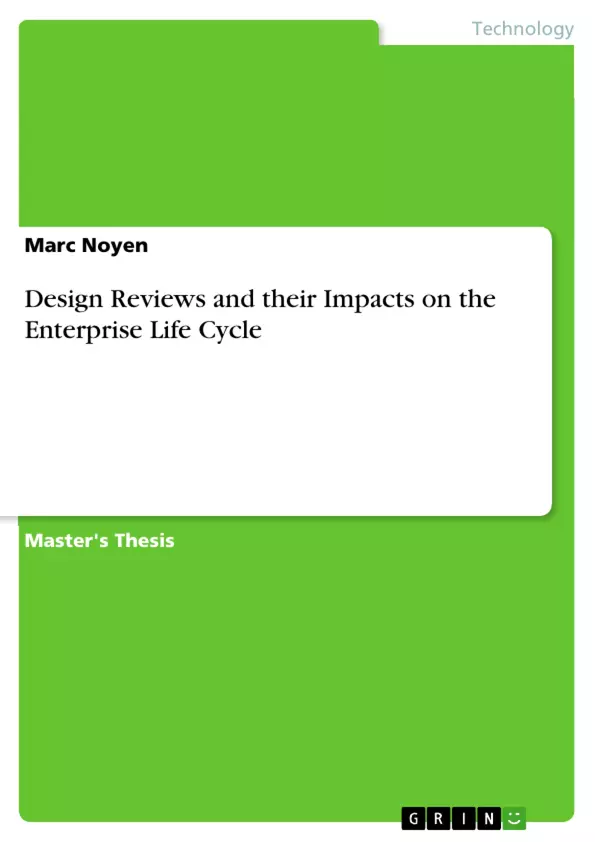The design and development of general Product Life Cycles (PLC) and Enterprise Life Cycles (ELC) has received significant attention over the past years. The EDENTM Software Environment developed from Indutech (Pty) Ltd provides roadmaps for both life cycles. These roadmaps allow the involved development team to follow a predefined step-by-step structure for their respective project.
As a PLC always belongs to a superior ELC, both life cycles cannot be considered independently. Changes and decisions of one of the life cycles usually have an impact on the other. And although the PLC and ELC are well explored, there does not exist a model which reveals those important interfaces between both life cycles.
This thesis aims on the detection of impacts of the PLC on the ELC. As the Design Review (DR) is a crucial key control element in the development process, the detection of the links is done by means of such DR. After giving general information about DR and providing definitions and descriptions of DR in the PLC and ELC, an impact-matrix is developed which shows the detected interference of the ELC by decisions of DR conducted in the PLC.
Table of Contents
- Abstract
- Chapter 1: Introduction
- 1.1: Background of the Research
- 1.2: Scope and Objectives
- Chapter 2: Product Life Cycle (PLC)
- 2.1: General PLC Model
- 2.2: The Role of Design Reviews in the PLC
- Chapter 3: Enterprise Life Cycle (ELC)
- 3.1: General ELC Model
- 3.2: The Role of Design Reviews in the ELC
- Chapter 4: Impacts of Design Reviews on the Enterprise Life Cycle
- 4.1: Impact Matrix Development
- 4.2: Analysis of Impact Matrix
- Chapter 5: Conclusion and Recommendations
Objectives and Key Themes
This thesis aims to investigate the influence of Design Reviews (DR) on the Enterprise Life Cycle (ELC), specifically focusing on the interactions between the Product Life Cycle (PLC) and ELC. The research explores the EDENT Software Environment, developed by Indutech (Pty) Ltd, which provides roadmaps for both PLC and ELC development. By analyzing the impact of DR decisions within the PLC, the thesis seeks to uncover the underlying connections and dependencies between the two life cycles.
- The impact of Design Reviews on the Enterprise Life Cycle
- The relationship between Product Life Cycle and Enterprise Life Cycle
- The use of the EDENT Software Environment for life cycle management
- The development and analysis of an impact matrix to identify key dependencies
- The role of Design Reviews as crucial key control elements in development processes
Chapter Summaries
Chapter 1: Introduction provides background information on the research and outlines the scope and objectives. It contextualizes the study within the larger field of Product and Enterprise Life Cycle management.
Chapter 2: Product Life Cycle (PLC) presents a general model of the PLC and discusses the role of Design Reviews in managing and controlling development within this framework.
Chapter 3: Enterprise Life Cycle (ELC) introduces a general model of the ELC and explores the function of Design Reviews within the broader context of the enterprise lifecycle.
Chapter 4: Impacts of Design Reviews on the Enterprise Life Cycle delves into the identification and analysis of the effects of Design Reviews on the Enterprise Life Cycle. It focuses on the development and interpretation of an impact matrix to visualize and understand these interdependencies.
Keywords
The main focus of this thesis lies in the investigation of the Design Review's impact on the Enterprise Life Cycle. Key topics include the Product Life Cycle, Enterprise Life Cycle, EDENT Software Environment, impact matrix, key control elements, and development processes.
- Arbeit zitieren
- Marc Noyen (Autor:in), 2004, Design Reviews and their Impacts on the Enterprise Life Cycle, München, GRIN Verlag, https://www.grin.com/document/50202



